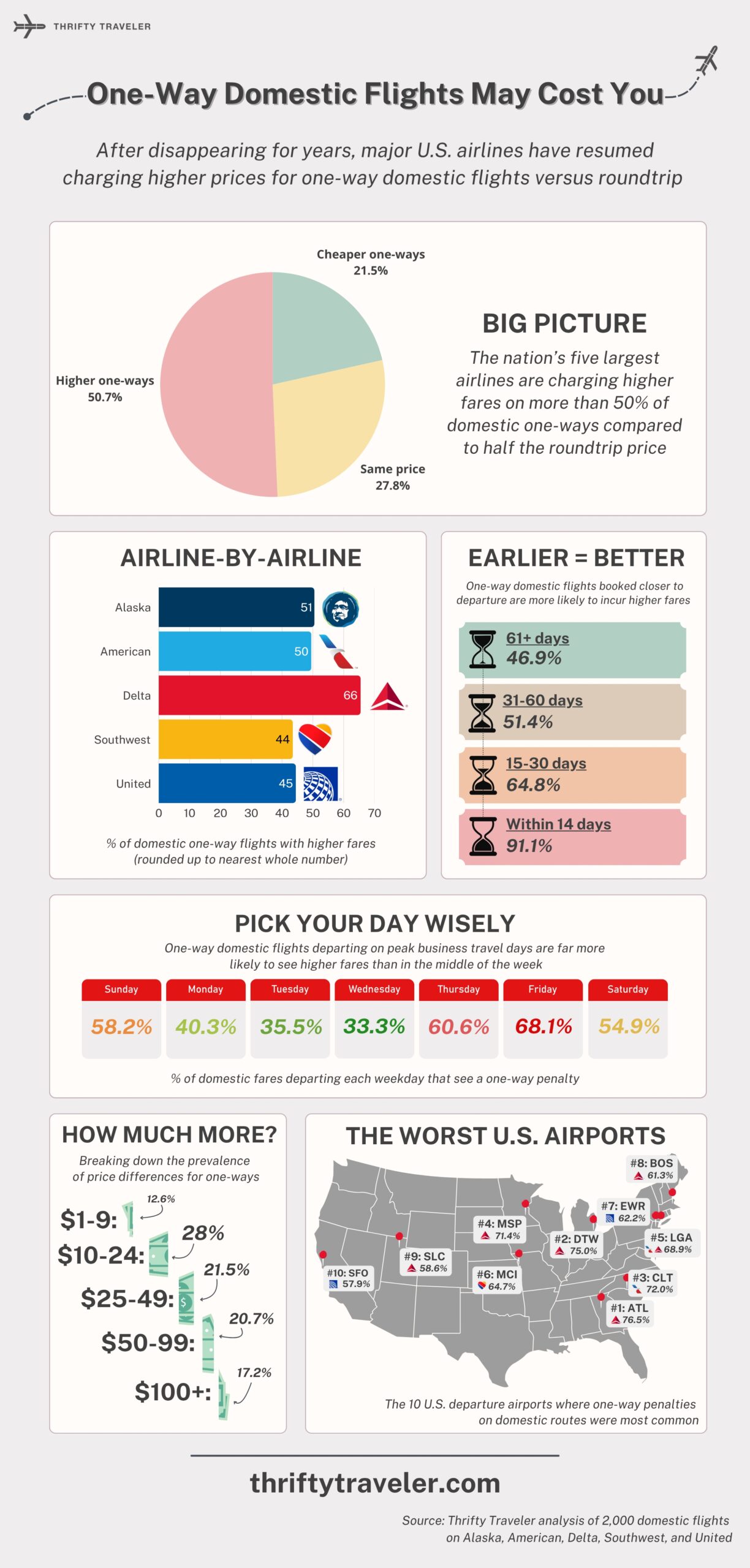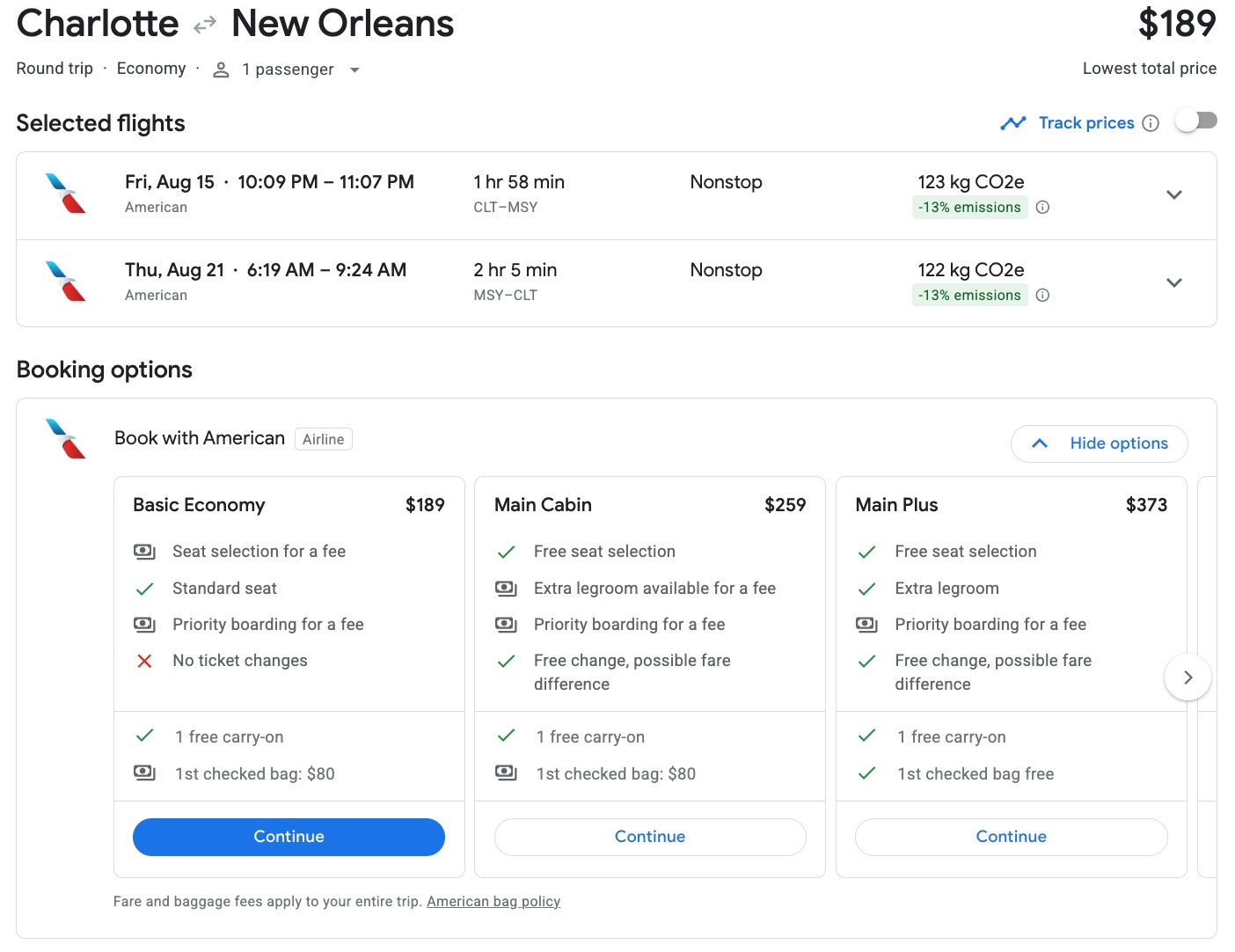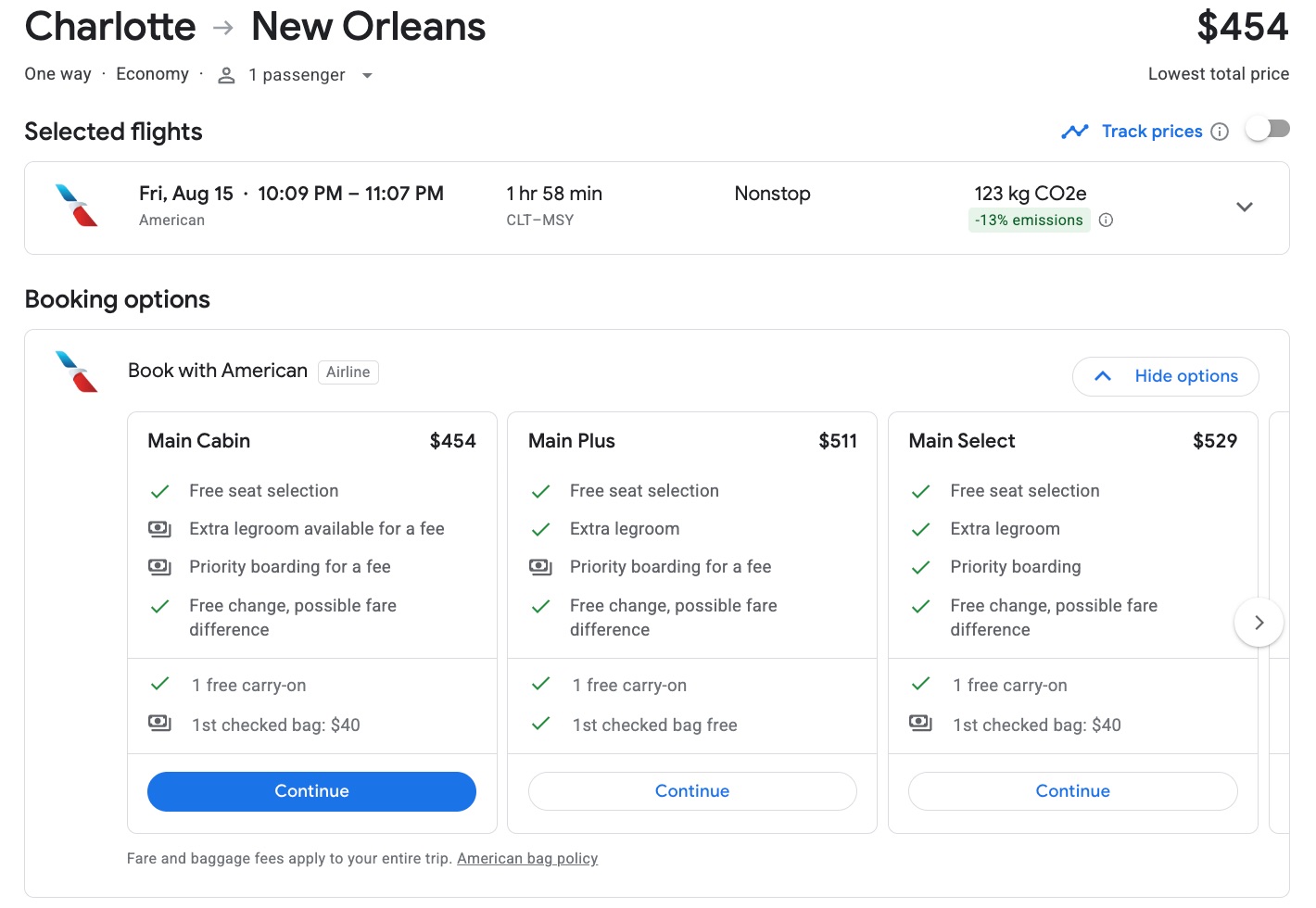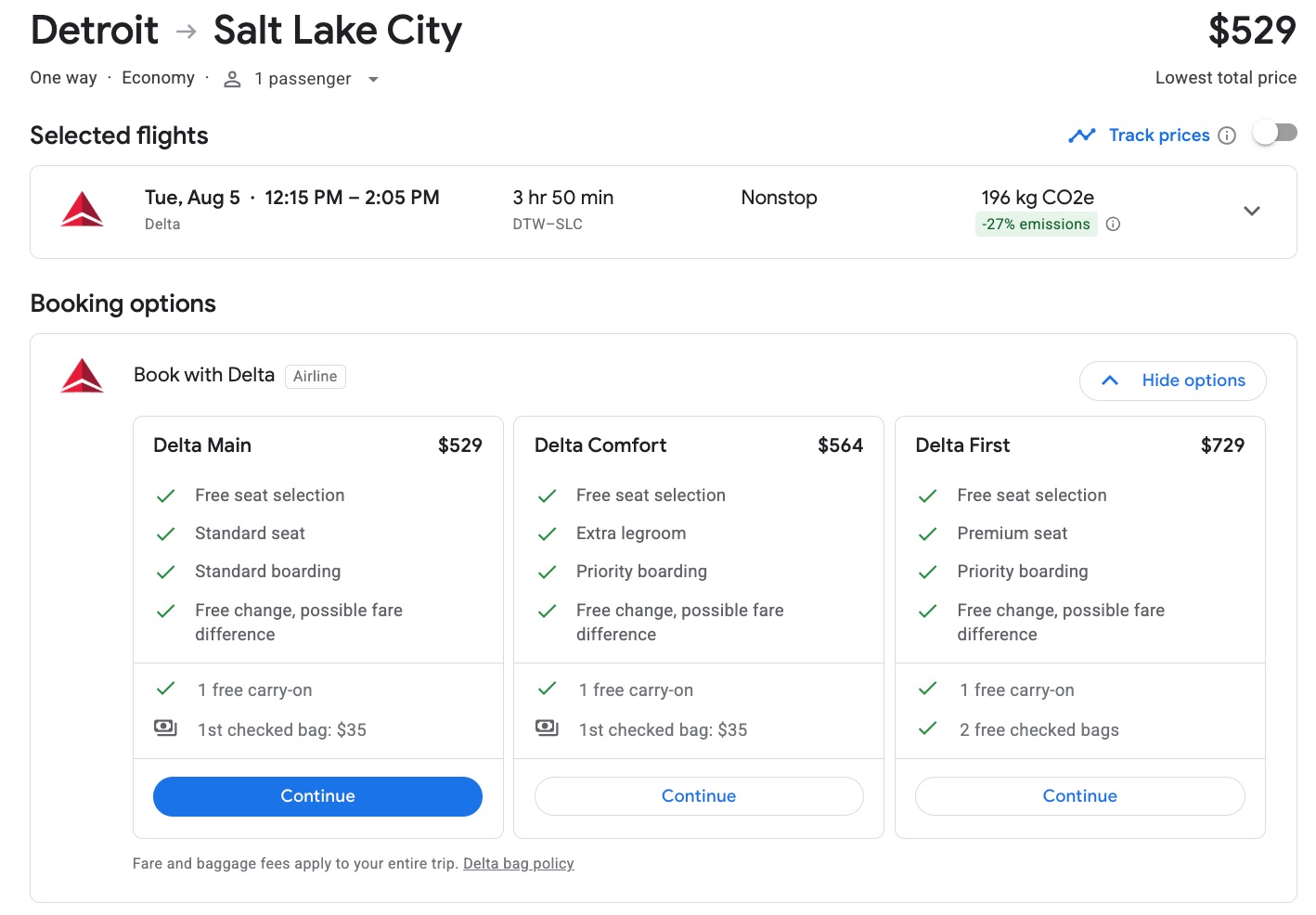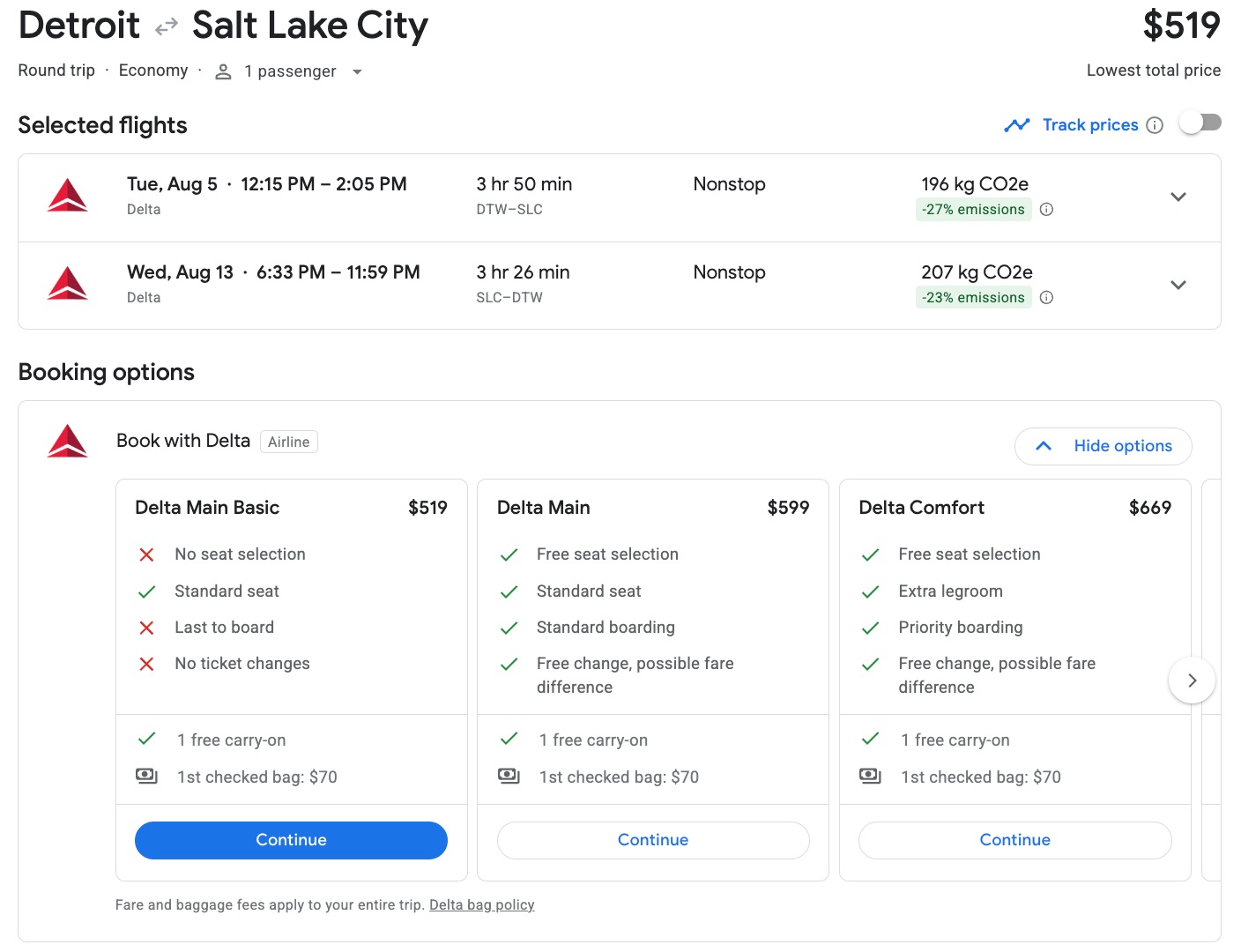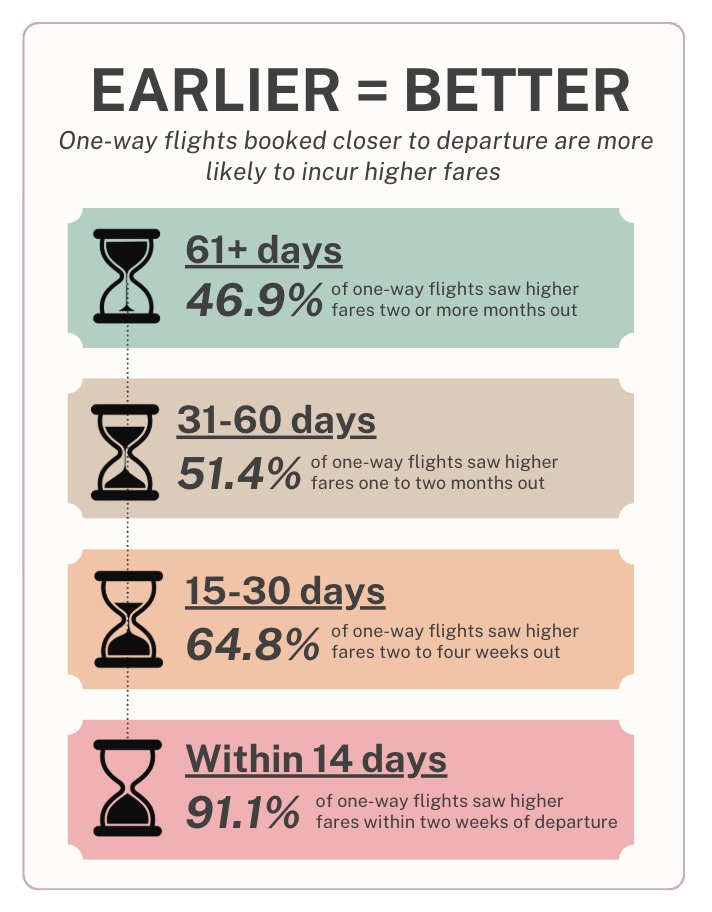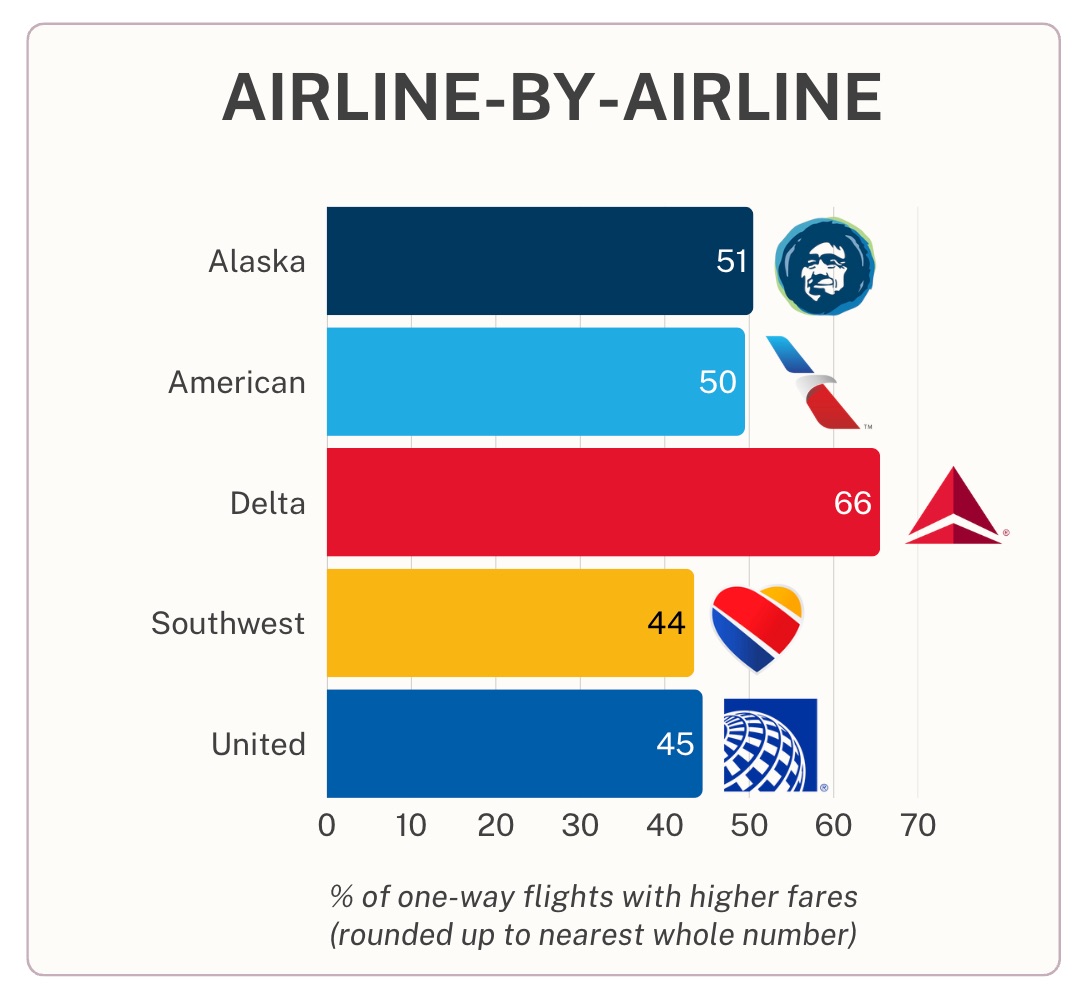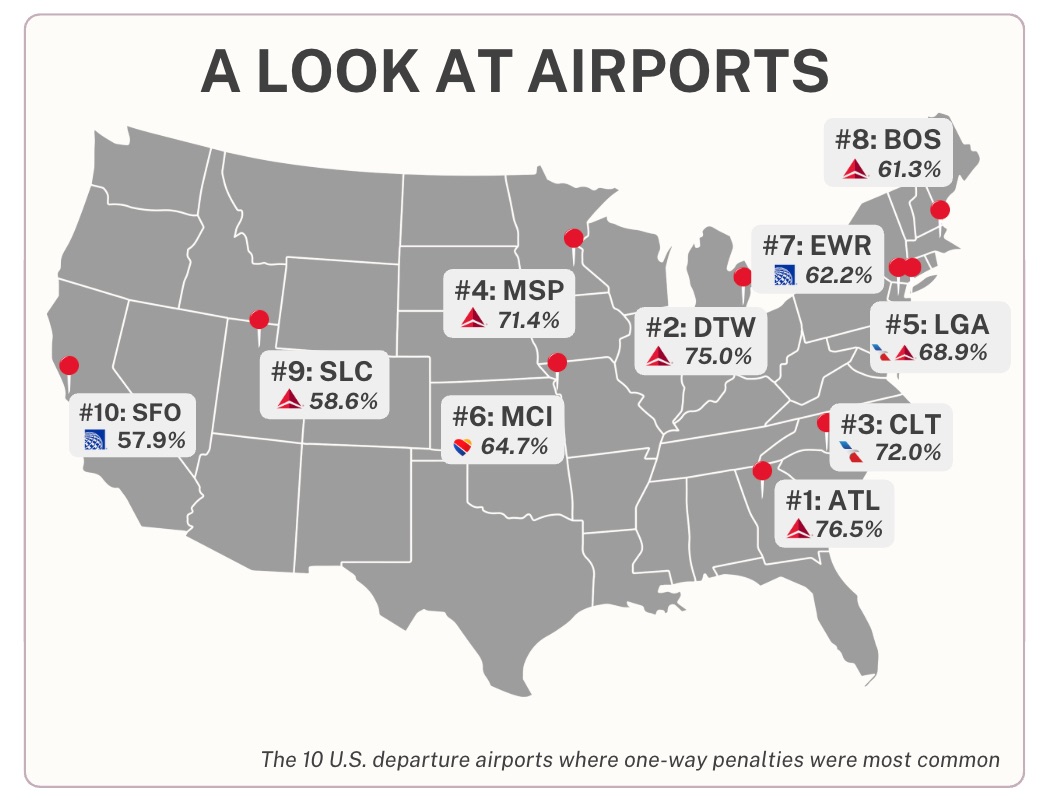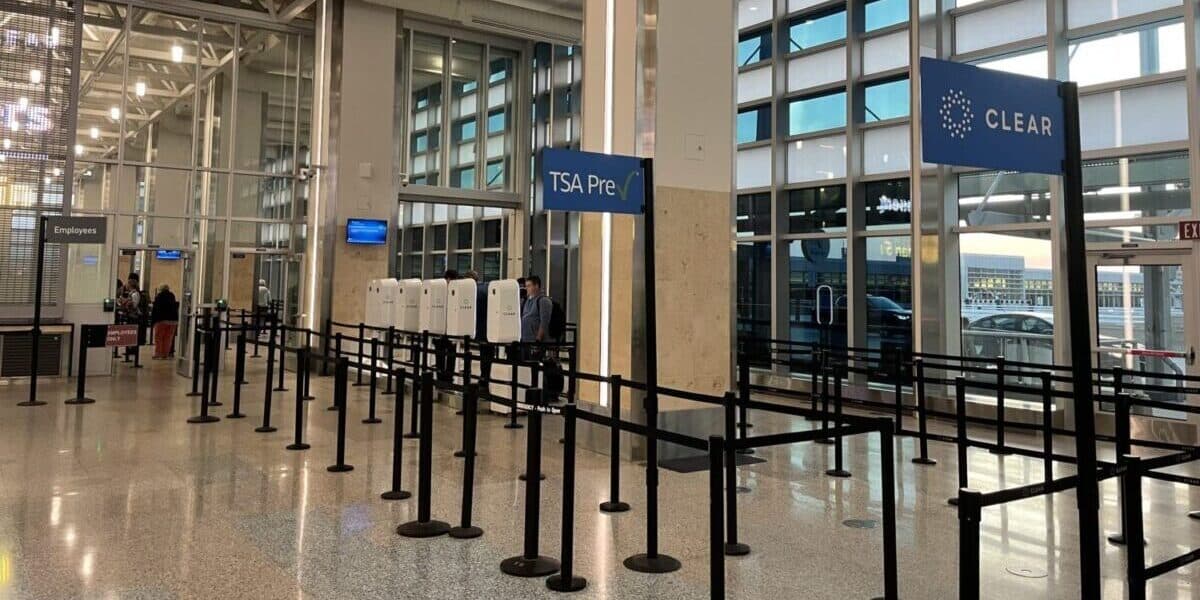For years, we've urged travelers to book domestic flights separately as one-ways – and we're not alone. They're almost always half the price of a roundtrip, the logic went, giving travelers far more flexibility for the same price.
But in 2025, that tried-and-true travel tip could easily be costing you: One-way booking penalties have roared back with a vengeance, our research has found.
Thrifty Traveler searched and analyzed 2,000 domestic flights – comparing prices for 1,000 one-way routes against 1,000 more with a return added – and found that the nation's five largest airlines were charging higher fares per segment on more than half of one-way flights. We searched one-way and roundtrip fares on Alaska, American, Delta, Southwest, and United from some of their largest hubs to random U.S. destinations earlier this month.
The penalties for booking one ways separately can range wildly. Some were just a mild, $3 or $4 more each than you'd pay booking roundtrip. But in other cases, it'd cost you another $100-plus each way – including a few dozen examples where a roundtrip fare actually cost less than a one-way booking on the same route.
Click below for a full version of this infographic!
These one-way booking penalties were once commonplace – a way for airlines to get higher fares out of business travelers paying with corporate cards. And for long-haul international flights, one ways still are (and always have been) significantly more expensive. But that pricing tactic largely faded away in the U.S. more than a decade ago as the rise of low-cost carriers forced legacy airlines to compete on price for cost-conscious everyday travelers and vacationers.
With business travel back to pre-pandemic levels and many budget airlines now on the ropes, one-way penalties are making a comeback … but not across the board. Our research found:
- 50.7% of one-way domestic flights on the five biggest U.S. carriers were priced higher per segment than a roundtrip booking with a return. Airlines charged the same fares per segment on 27.8% of routes, while one-ways were cheaper on 21.5% of flights.
- Delta has gone the furthest with restoring one-way penalties, with higher fares on 66.5% of one-way flights. All other U.S. airlines are charging higher one-way fares on roughly 50% or less of their domestic flights
- The closer you are to departure, the more likely you're paying extra for a one-way flight: One-way flights booked 60-plus days before departure were more expensive than roundtrips in 47% of cases. But book within a month, and that increased to 75% … and 91.1% within the last two weeks.
- The day you fly matters too. Frequent business travel days like Sundays, Thursdays, and especially Fridays were the most likely to see one-way penalties while flights departing Tuesdays and Wednesdays were the least likely to be penalized, at 35% or less.
- The rise in dynamic award pricing – with mileage rates closely tied to cash prices – means you're likely to pay more when booking one-way flights using miles, too.
It's yet another way to squeeze more money out of select travelers. Earlier this year, we broke the news that American, Delta, and United had all quietly begun charging solo passengers significantly higher fares – a practice that all but American Airlines has since backed away from after an uproar.
But while that was a new and novel pricing tactic for airlines, longtime aviation journalist and industry expert Brian Sumers called the rise of one-way penalties “a return to the past.”
“Airlines want business travelers to pay a lot more for their fares,” said Sumers, who writes The Airline Observer newsletter and co-hosts The Air Show podcast. “There are very few companies that need a $99 fare from Los Angeles to San Francisco – they can pay twice as much, if not more, if the meeting is important. But too often, businesses have been grabbing fares meant to get leisure customers off the couch, and airlines would like to put an end to that practice.”
Still, it will come as a shock to many travelers – whether they're traveling for work, fun, or booking a positioning flight ahead of a big international trip – who have defaulted to booking one-way fares for years, even decades.
The Skinny on Higher One-Way Fares
With prices that seem to change by the second, airfare is both mystifying and frustrating to the average traveler … and yet surprisingly simple, even antiquated. The return of these one-way fare penalties supports both points.
While travelers may only see first class, extra legroom and standard economy seats on the plane, airlines sell an alphabet soup of different fare classes, each with their own set of rules, restrictions, and – most importantly – a different price. From solo passengers to one-way flights, airlines use those different rules and requirements to push consumers into cheaper (or pricier) fares.
It's all about “segmenting” their customers – most importantly, charging business travelers paying with a corporate card more while offering a better deal to families on the exact same flight. That's the entire reason why stingy basic economy fares exist. In the past, airlines have also written “minimum stay” requirements or “Saturday day” restrictions into the rules of their cheapest fares – so if your search for a roundtrip didn't last at least a week or include a Saturday, airlines would force you into a pricier ticket.
Like requiring a roundtrip to get the cheaper fare, both of those pricing tactics had fallen out of favor. But over the last year or so, our research shows one-way penalties have mounted a serious comeback. For example, it's glaringly obvious on this American Airlines flight from Charlotte (CLT) to New Orleans (MSY) next month.
Search for a six-day roundtrip departing Aug. 15, and you can book for as low as $189 in American Airlines basic economy – or $259 total for a standard economy fare.
For years, booking a flight like this as a roundtrip or separately with one-ways didn't make a cent of difference: A one-way would be half the cost of a roundtrip. But now, booking that exact same 10:09 p.m. departure as a one-way ticket will cost you $454 for a main cabin seat – almost double the cost for half of the trip. A cheaper basic economy fare isn't even available as a one-way.
That's an extreme example, but there are plenty more.
For instance, booking Delta from Detroit (DTW) to Salt Lake City (SLC) on Aug. 5, the airline is charging $529 for a standard economy seat.
But add a return flight a week later, and the total roundtrip price for the same main cabin fare clocks in at $599 – under $300 each way. Plus, an even cheaper “Delta Main Basic” – aka basic economy – fare is available when booking roundtrip.
Delta, American, and other airlines are trying to squeeze more money out of travelers by selling their cheapest fares with a rule requiring a roundtrip booking. If you search for just a one-way flight from Charlotte to New Orleans or Detroit to Utah, you skip right past those cheaper options and only see a pricier ticket.
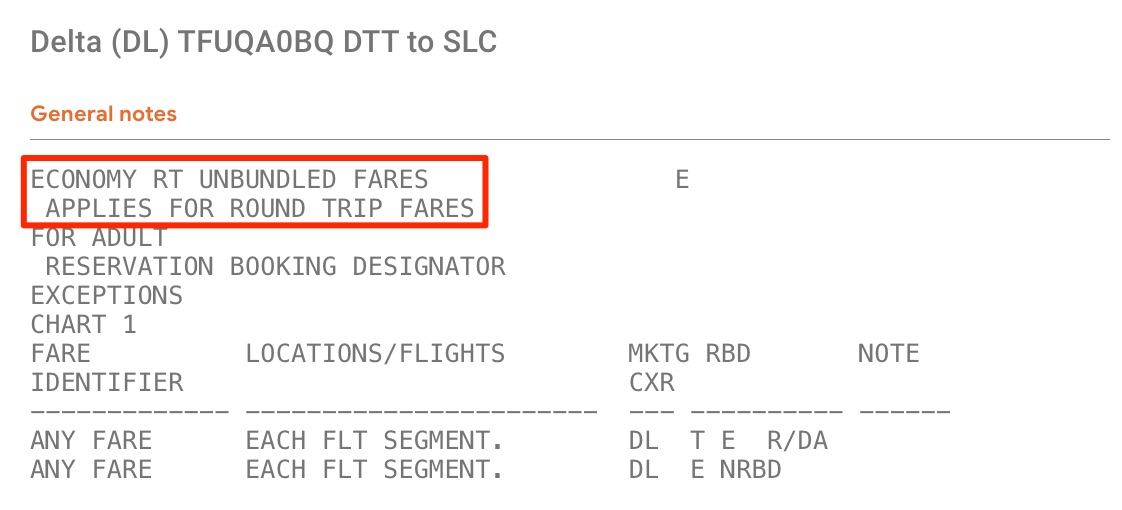
These higher one-way fares are far more familiar than the solo passenger penalties American, Delta, and United levied earlier this year. In fact, Sumers said most domestic one-way fares were exorbitantly expensive in the 1990s compared to the $10- to $200-plus premium major U.S. airlines have resumed charging recently.
Sumers sees a direct correlation between the recent struggles of low-cost carriers (or LCCs) like Spirit and Frontier and the return of these higher one-way fares.
“LCCs are in trouble in the United States, and they're not making nearly as much money as they once did. Legacy carriers are no longer as threatened by them,” he said. “They have realized they don't need to sell everything as a one-way fare, just because Frontier does. They can return to some of their old ways.”
Higher one-way fares have officially made a comeback … but not everywhere. Where – and when – airlines are redeploying this pricing tactic clearly targeting business travelers.
Book Early & Pick Your Weekdays Wisely
If you want to book one-way flights without paying for it, it pays to plan ahead.
Airlines bank on business travelers booking late, knowing they can easily charge higher fares for a last-minute flight to New York or Los Angeles for a meeting. Their rollout of higher one-way fares follows the same pattern: Booking a one-way flight just a few weeks before departure makes it far, far more likely you'll pay a higher price.
Booking at least two months before departure, we found airlines were charging higher one-way fares on less than 50% of flights. But within a month, that increased to 75% … and within the final 14 days before departure, a whopping 91.1% of one-way flights were seeing higher fares than the roundtrip per segment cost.
Whether you're trying to avoid paying higher fares for a one-way ticket or just trying to find a good deal on any flight, it's less about the day you book and more about the day you actually get on the plane. There's a huge disparity for this rise of one-way penalties.
Flying on an off-peak day like a Tuesday, just 35.5% of one-way fares we searched were subjected to higher fares than the per segment roundtrip cost – and just a third for flights departing Wednesdays. But departing on busy business travel days like Sunday and especially Friday, it flips: We found airlines were charging higher fares on 68.1% of one-way departures on Fridays.
Delta Leads (?) the Way
Among the nation's largest airlines, most are penalizing roughly half (or slightly less) of their one-way flights with higher fares, our research shows.
And then there's Delta, where we found nearly two-thirds of one-way flights were being charged higher per segment fares than a roundtrip on the same route.
Delta's one-way penalties aren't just the most prevalent among U.S. airlines but also the most severe. Our research found a $50 median price difference for a one-way versus roundtrip booking on Delta, above American Airlines with a $48.50 price gulf.
On the other end of the spectrum, there's Southwest. Our analysis found that Southwest had both the lowest prevalence of higher one-way fare and the mildest penalties, too, with a median price differential of just $18 per segment.
You can really see Delta's frequent use of charging higher one-way fares in this map plotting the top 10 U.S. airports. Six of the top 10 departure airports where we most frequently found higher one-way fares were major Delta hubs – and among the top five, four were Delta hubs including Atlanta (ATL), Detroit (DTW), Minneapolis-St. Paul (MSP), and New York City-LaGuardia (LGA).
While Delta hubs dominate the list in how often the airline is selling higher one-way fares, American takes the cake for charging passengers more. Case in point: Flights from the airline's Charlotte (CLT) hub saw higher one-way fares in our research than any other airport in the country, with a median price difference of $212.50 higher than the roundtrip per segment cost.
Bottom Line
For years, travelers (including yours truly) have defaulted to booking one-way flights. As airlines resume charging higher fares for a one-way ticket, it may be time to change our ways.
After disappearing for more than a decade, airlines have restored higher fares for booking a one-way flight instead of a roundtrip. Our research found higher one-way fares on more than 50% of the domestic routes we searched … and given how quickly these one-way penalties have spread, there's no telling how much more common those higher fares will be in the months to come.

